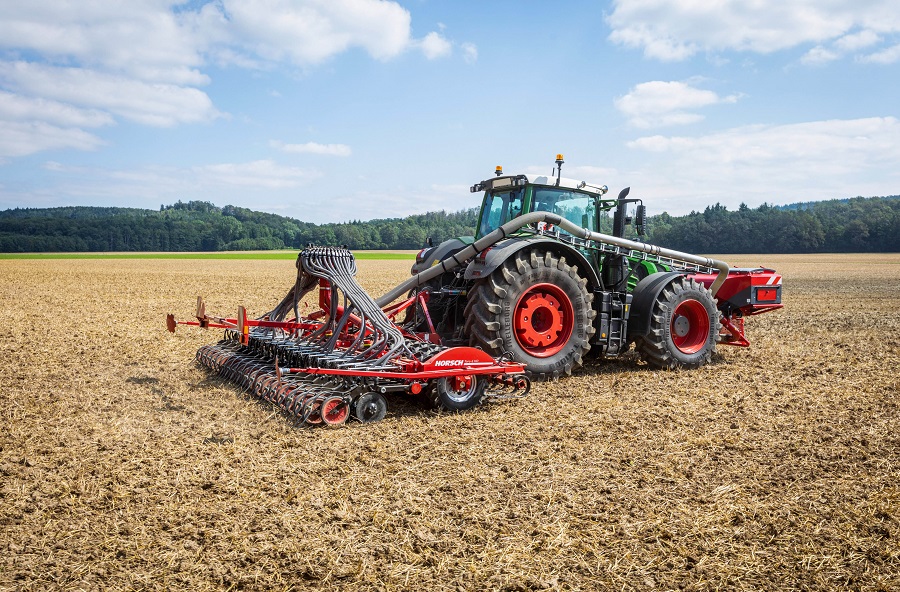A recent study by Rothamsted Research has shown that 38% of arable soils in England and Wales are degraded, so how could the drill play a role in improving this? CPM speaks to the experts and takes a look at what’s new on the market.
Reducing soil movement should lead to reduced fixed costs in the longer term.
By Charlotte Cunningham
For some time now, the industry has struggled with a way of benchmarking soils based on carbon-clay ratio, but last month, Rothamsted Research announced that it’s finally been able to develop an easy to use index.
Based on the findings of a number of European studies, the new index classifies soils by the proportion of organic matter vs clay that they contain, giving a good idea of how much carbon they can take up and store – vital in the fight against climate change – as well as a general indicator of how well they are functioning.

Rothamsted Research has developed an index to benchmark soils based on a carbon-clay ration
“Soil carbon is vital for the proper functioning of soil, but it’s absolute value alone is not always a true reflection of a soil’s health due to the very varied nature of different soils,” says lead author and PhD student, Jonah Prout.
“By analysing a wide range of soils from across England and Wales, we were able to test this index as an indicator of soil structure – of key importance to soil functioning – and a measure of whether a soil needs improving.”
The ratings are largely independent of climate, soil type or the type and amount of vegetation growing on it. This provides a true indication of the status of the soil, he adds.
But while this is seemingly good news for the industry, the index was subsequently able to calculate that 38% of arable soils in England and Wales are degraded – compared with 6.6% of grassland and 5.6% of woodland sites – suggesting there’s serious room for improvement.
With this in mind, and combined with the increasing pressure from a legislation point of view to do more to protect soils, it’s worth considering what kind of influence your choice of drill has on soil health, according to Harry Henderson, knowledge exchange technical manager at AHDB.
“In terms of cultivations, and specifically drilling, the trend is still towards reduced soil movement, and it’s all a bit of a waiting game at the moment to see if, and how, this is reflected within ELM policies going forward. The truth is, we just don’t know yet.
“However, what we can start to think about in the meantime is the type of system growers may choose to adopt in light of any legislative changes. And when it comes to your choice of drill, it’s going to be the soil type that dictates this.
“For example, those with sandy or silt types will always want a scratch, so some slight movement is often necessary. Whereas growers with clay soils could sway more towards a no-till system with a disc.”
Harry reckons that ultimately the choice for many will boil down to picking between a tine-based or disc system. But what about those with mixed soil types?
“There will be growers that farm over a wide range of soil types, and where this is the case, I recommend opting for a disc system with very good depth control options.”
When it comes to the specific drill for the job, Harry says it’s important to think of the long-term usage, as well as the immediate. “It’s crucial to consider what type of future you see for the farm and the crops,” he says. “For example, will you include cover crops over the years to come? If there’s a reduction in OSR area, cover crops may take that late Aug/early Sept slot, and it’s important the drill you invest in has the capacity to cater for that.”
While reducing cultivations is critical when it comes to protecting the future of UK soils, it’s just one element of working towards easier working soils, believes Harry. “Any farmer worth their salt will be thinking strategically about the next 5-10 years as a whole and this will include both reduced cultivations and soil enhancement measures – such as more crop residue and cover crops – to ensure soils are more workable going forward.”
Another important factor in this will be rethinking cropping options and optimising longer rotations where possible, he adds. “Historically, rotations were just two wheats followed by OSR, but now the need for increased grass weed control coupled with reduced herbicide options could mean four, five or six crops with a significant proportion of spring crops are drilled.”
To make the most out of these longer rotations, Harry advises that it’s worth considering crops that don’t always look profitable on paper. “To make it work, growers may want to look at crops such as linseed, beans and peas. From a financial point of view, while the commodity price itself is unlikely to increase, where growers can make a difference is by targeting fixed costs.
“Adopt a lighter touch machinery wise, and use cover crops that are established with as much care as the cash crops. Reducing soil movement should lead to reduced fixed costs in the longer term.”
For those thinking about something new, while the LEADER funding grants have now come to an end, Harry believes there could be new opportunity around the corner. “If you’re in the mood for something new, I would be very tempted to keep an ear to the ground over the next 12 months. There will be a great impetus to get us off the blocks following Brexit, and now COVID, so I’d advise sitting tight for the next year or so if grant funding is something you’d be looking for.”
Manoeuvrable seeding
A new mounted disc drill has been launched by Horsch to provide a manoeuvrable seeding system that’s ideal for smaller and irregular fields.
The new Taro HD and Taro SL drills have a 6m working width that enables them to cover the ground efficiently and are combined with a front-mounted Horsch Partner hopper for a compact design.
The Taro 6 HD is equipped with a tyre packer and PowerDisc seed coulters, with the packer levelling and creating consistent sowing conditions in front of each coulter, according to the manufacturer.
The Horsch Partner front tank is available with either 1600-litre or 2200-litre capacities and optimises the weight distribution of the tractor and seeding rig. An offset method enables separate passes for tillage and sowing and offers greater sowing flexibility, especially in years with high rainfall.
At 3000kg deadweight, it’s light for a 6m machine and is also available with 12.5cm and 15cm row spacings, says the firm.
Also new from Horsch is an AirSpeed overpressure metering system for the 2021 Maestro drill to complement the AirVac vacuum metering system it unveiled at Agritechnica last year.
The firm announced its new generation of Maestro precision drills with the launch of the Maestro CV and RV at last year’s Agritechnica – which feature the AirVac system But the new AirSpeed system gives farmers a choice of metering technologies that allows the machine to be adapted to the individual requirements of the farm.
The updates increase the Maestro range to five models (CV and CX, SV and SX, RV) with 6 to 36 rows making it the largest range of precision single-seed drills on the UK market, claims Horsch.
In addition to the new metering systems, features such as a new clamping profile for easy row adjustment make the new Maestro even more effective.
So how exactly does the AirSpeed system work and how does it compare to AirVac?
“AirVac uses a vacuum for reliable singulation and high precision for sowing speeds up to 12km/h,” explains Stephen Burcham, general manager at Horsch UK.
“AirSpeed uses overpressure for precise singulation giving optimum plant spacings at high operational speeds. It offers consistent embedding of the grain by means of a shot system and a catching roller for maximum power and efficiency.”
Both systems can be used for precise grain singulation in a wide variety of crops including maize, sugar beet, sunflower, soya and OSR with further crop types, such as beans and peas, possible in the future.
The scraper doesn’t need to be adjusted or changed between crops, requiring only the correct metering disc, and therefore reduces seed handling considerably. “A grain sensor provides information about the singulation accuracy and as both systems are driven electrically, technologies like SectionControl and VariableRate for every individual row can still be used.
The seed body has also been revised for higher stability and a high hydraulic coulter pressure, adds Stephen. “It’s connected to the main frame with a new clamping profile that makes it easy to alter the number of rows from 12 to 8, a key requirement for customers.
“The fertiliser is applied via a single disc fertiliser coulter and its depth can be controlled separately, which is particularly helpful on heavy, sticky soils. It’s attached to the row unit and the row spacings can be modified easily.”
Supplementary seeders
Kuhn has introduced a range of supplementary seeders that can be fitted to its Venta, Espro and Aurock pneumatic drills to facilitate progressive practices such as companion cropping or to apply fertilisers, granular herbicides or slug pellets while drilling.
The smallest model in the SH seeder range is the SH 1120, with a 110-litre hopper. In this case, air from the drill’s main fan is used to direct product into the venturi to enable it to be applied with seed from the main tank.
The larger SH 1540, SH 2560, and SH 4080 models, with 150, 250 and 400-litre hopper capacities respectively, are equipped with their own electrically driven fans and apply product via splash plates behind the main seeding lines, says Kuhn.
All models use Kuhn’s Helica volumetric seed metering system to maximise the accuracy of output and application rates are controlled through the ISOBUS system in relation to the forward speed of the tractor.
“The SH seeders are an effective way of adding great versatility to Kuhn pneumatic drills,” says Kuhn UK product specialist Ed Worts. “With the main drill sowing seed in the usual way, the SH seeder can be used to sow a secondary seed, such as a companion crop used to suppress weeds, add soil fertility or act as a pest deterrent, for example.
“The SH seeder can also be used to apply starter fertiliser, slug pellets or a granular herbicide such as Avadex, such is its versatility and adaptability.
“In the case of the Espro RC and Aurock RC, which have split hoppers as standard, the SH seeder adds a third application possibility. This allows a variety of applications to suit individual requirements and reduces the need for expensive seed mixtures.”
On the larger SH 1540, SH 2560 and SH 4080 models, application rates between 2.2kg/ha and 130kg/ha can be accurately achieved alongside the application from the main drill, he adds.
At the start of the year, Kuhn also announced that row by row seed rate variation was now possible in electrically driven models of the Maxima 3 precision drill range.
Available on machines from 6 to 12 rows, and with row spacings from 37.5cm up to 80cm, electric-drive technology allows variation of seed rate row by row. This can be carried out manually from the tractor cab or as determined by a variable rate map, says the firm.
Work carried out by Kuhn in the development of the technology has shown that varying the seed rate in response to soil conditions can lead to seed savings of 2-3% when used in conjunction with section control (automated row shut-off). In addition to seed savings, variable seed rate also optimises plant populations according to available water and soil nutrients, with this resulting in an overall potential yield gain of between 5 and 8%.




